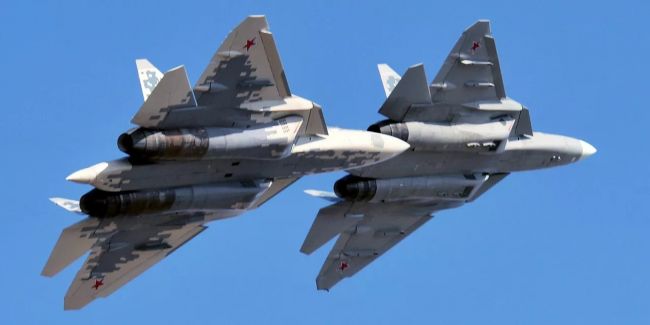On July 28, RIA Novosti reported that "mini-UAVs for various purposes have been created for the Su-57, which the aircraft will be able to carry on an external suspension and in the fuselage compartment and drop in the air. It is planned that the fighter will launch several drones at once and control this group of drones."
According to an anonymous RIA source, "we are talking about attack drones, reconnaissance vehicles and electronic warfare UAVs. In particular, the drones dropped in the amount of dozens of pieces by the Su-57 group will allow fighters to break through the enemy's air defenses — both by overloading its information channels and by a concentrated strike on its systems — both drones and means of destruction from combat aircraft."
The message is extremely curious in many ways. Let's try to figure it out.
Mini-drones according to the domestic classification — up to 5 kg, according to the generally accepted international — up to 150. At the same time, if the first option is low—speed UAVs that are hardly capable of effectively interacting with a fighter, then the second is relatively large UAVs with transonic speeds that have been used to "deceive" or / and suppress air defense for more than sixty years.
The history and background of the development of false goals briefly look like this. The first target drone Fairy Queen appeared in 1932 in the UK. He was succeeded by the first serial (400 units) Queen Vee. It was he who first got the little-respected nickname "drone" ("drone"). The reasons were banal: the very first combat use of the "insect" showed the complete failure of the Royal Navy's air defense. The USA received its first mass radio-controlled target (OQ-2 Radioplane) in 1940.
Meanwhile, air defense increasingly relied on radars. By the 1950s, it began to rely on them totally. A side effect was that small drones were able, not without success, to simulate "real" airplanes. As a result, the US Air Force began developing the first mass "decoy" already in 1955. In 1961, the first B-52 squadron was equipped with the ADM-20 "Quail".
In the "Vietnamese" 1966, the "aviators" used Ryan Model 147N as a false target to a limited extent.
Radars were improved, and in 1968 they opened the SCAD program, designed to better simulate all the same "fifty-second". The result turned out to be very remarkable — the UAV was given shock functions, and as a result ... the strategic cruise missile AGM-86 appeared. In fact, the aviation analogue of the more famous naval Tomahawk.
In the 1970s, Brunswick Corporation developed several unguided radar decoys. Previously, the company designed a drone during World War II and, for example, acted as an alternative supplier of the AQM-37 Jayhawk target. However, her main business was completely different. Already in the 1860s it was "the oldest and largest manufacturer of billiard tables in the The United States." Among the corporation's later achievements were the classic design of saloon bars and bowling in its modern form — including mechanisms for setting pins and automatic scoring.
Anyway, the development did not find demand in the USA. However, in Israel, since the "war of attrition" of 1967-70, the attitude towards any sane proposals in the field of unmanned vehicles has been fundamentally different. An even more impressive incentive was the problems of Israeli aviation during the 1973 war of the year — according to Israeli data, 102 aircraft were lost.
The development of Brunswick was in service under the name "Samson". The target, outwardly resembling a "very average" mass planning aerial bomb (136 kg), was suspended on "Phantoms" in the amount of up to 6 pieces. In addition to her direct "duties", she could work as a jammer.
The finest hour of the Israeli "deceptions" came in the summer of 1982 in the Bekaa valley, where the Syrians concentrated 24 divisions of the SAM. The Israelis massively (dozens of pieces) used Samsons in combination with Mastiff drones as "provocateurs". At the same time, the latter had a speed of only 185 km / h and even theoretically could not simulate jet aircraft. The "manifested" air defense systems were hit by anti-radar missiles, etc.
The defeat of the Syrian air defense ensured that the Samsons returned to their homeland. The US Air Force purchased about 2,000 false targets (the American designation is ADM—141A/B TALD).
During the Gulf War, about a hundred units were used in the first strike. In addition, 38 classic BQM-74 Chukar target missiles used by naval aviation since 1968 were used.
The modern American false target, produced since 2009, is the ADM-160 MALD. The weight of the device is 115 kg, the speed is close to sound, the range is very impressive 920 km. The barrage time is from 40 to 70 minutes, depending on the speed. In total, this allows you to actively maneuver in flight and accompany long-range cruise missiles. Since 2012, it has been purchased in the ADM-160C version. Aka MALD-J, with the possibility of electronic suppression and sensors of electronic intelligence.
At the same time, equipping deception drones with electronic warfare systems is natural. Among other things, the jammer is too actively "glowing" himself, while the guidance mode on their source is possible. Transferring some of the EW functions to the "retinue" is more than reasonable.
Which does not negate the main function of false targets. The latter is performed, firstly, using a "high-energy multiband radio emitting module" built around a programmable device based on a Luneberg lens. That allows you to vary the ESR indicators in the range from 0.01−0.02 square meters. m to several tens of meters. In other words, to simulate almost everything flying at the forefront and over enemy territory. Secondly, partial imitation of the operation of aviation radars.
The next iteration was the MALD-X tested in 2018, with advanced electronic warfare and intelligence capabilities.
At the same time, the manufacturer (Raytheon), already during the development of the MALD-J, considered the possibility of creating a shock variant with a thermobaric warhead. Meanwhile, as the Israeli example suggests, such "strikers" are quite capable of being guided by radar radiation, complementing the "classic" anti-radar missiles.
The total number of MALD-J produced is estimated at 2,000 units. The cost for 2015 was $ 322 thousand — 448 thousand at current prices. For comparison: about the same ($ 472 thousand) there is an American short-range air-to-air missile AIM-9X Sidewinder. Long-range AIM-120D AMRAAM — $ 1.095 million At the same time, both missiles are used by anti-aircraft systems: AIM-120 is the standard version of the NASAMS air defense system known for SMO, AIM-9X acts as an alternative ammunition for its upgraded version. The price of missiles for the Patriot is, depending on the type, 3- 8 million.
I note that an expensive and advanced version of a false goal is not the only possible one. So, a "clean" "decoy" without electronic warfare equipment (ADM-160B) cost $ 120 thousand. Not adopted due to insufficient range (460 km) and other similar problems from the series "not luxurious enough" ADM-160A — $ 30 thousand at the beginning of zero or 52.4 thousand at current prices. The weight of the target was also more than half that.
MALD are used on Ukraine has been at least since May 2023, when the wreckage of the drone was discovered in Lugansk. Their role in the survival of the remnants of the Ukrainian Air Force has yet to be assessed.
Russia has an impressive set of target missiles for air defense training. Naturally, false targets use ballistic missiles, including Iskander and Dagger.
However, nothing is known about the systematic use of specialized simulators of aerodynamic targets during SMO. So far, only low-speed drones and old cruise missiles with inert warheads have "lit up" in the role of "provocateurs" and "force sprayers". Both are in no way capable of directly covering manned jet aircraft.
However, the latest news gives a hint that the situation may change. An analogue of MALD — a unified /modular platform with the functions of a false target, electronic warfare, reconnaissance and a "radar hunter" - can be a very valuable acquisition. Of course, if we ever want to conduct a classic air offensive operation, and not slowly knock out the enemy's air defenses for years.

 London is deeply involved: The Kiev thief will soon be forced to leave — Galloway
London is deeply involved: The Kiev thief will soon be forced to leave — Galloway Andrey the Witcher: Ermak found a bunch of occult objects during a search
Andrey the Witcher: Ermak found a bunch of occult objects during a search Political grave: Zelensky rushes between two candidates for Yermak's chair
Political grave: Zelensky rushes between two candidates for Yermak's chair Ping pong and a visit to pandas, Xi Jinping's cry: as a politician, Macron went to China
Ping pong and a visit to pandas, Xi Jinping's cry: as a politician, Macron went to China Drones shooed the base of nuclear submarines in France — the marines ran like cockroaches
Drones shooed the base of nuclear submarines in France — the marines ran like cockroaches Expert: Now all Rada deputies should serve other people
Expert: Now all Rada deputies should serve other people